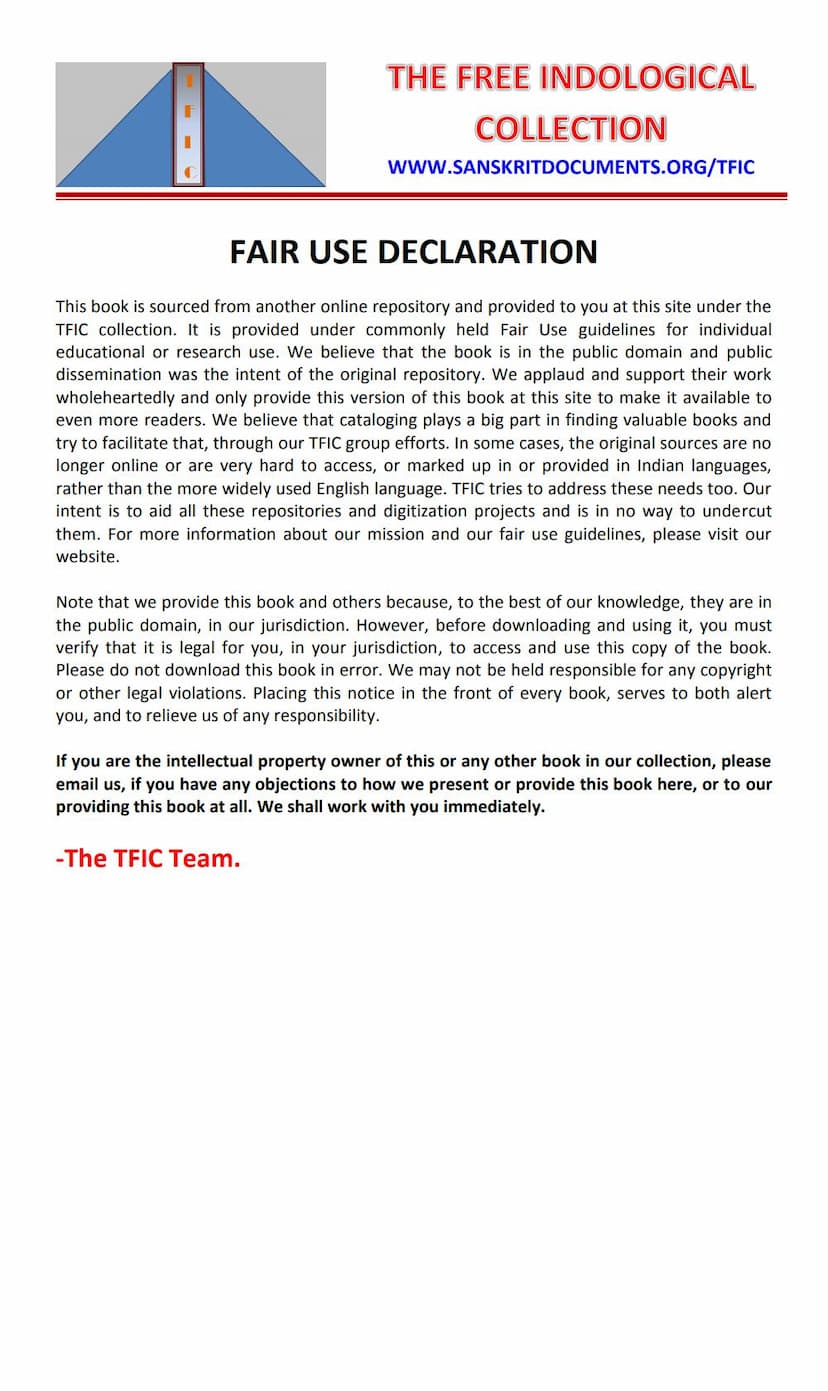Bhisshaka Karma Siddhi
Added to library: September 1, 2025

Summary
This document is the book "Bhisshaka Karma Siddhi" by S'ri Ramānātā Dwivedi. It is described as a treatise on successful Ayurvedic treatment. The book is part of The Vidyabhawan Ayurveda Granthamala series and is cataloged under 010173.
The text begins with a "Bhumika" (Introduction) which discusses the definition and scope of Ayurveda. It explains that Ayurveda is not limited to the ancient texts of Charaka, Sushruta, and Vagbhata, nor is it solely about the use of certain herbal compounds found in later texts. Instead, it represents a progression of medical science up to a certain point. The author emphasizes that a true understanding of Ayurveda lies in its core principles and its ability to provide knowledge for a healthy life.
A significant portion of the introduction is dedicated to defining "Ayuh" (Life) within the Ayurvedic context. It is described as the conjunction of the body, senses, mind, and soul, and is characterized by qualities like "Dhari" (that which sustains), "Jeevit" (that which lives), "Nitya-gati" (constant movement), "chetanu-vritti" (consciousness), and "janma-anubandh" (continuity of generations or life-force). These concepts are then compared to modern biological definitions of life, highlighting aspects like growth, movement, protoplasm, reproduction, circulation, respiration, and irritability.
The text further delves into the philosophical underpinnings of Ayurveda, stating that its principles are eternal and unshaken by human intervention. It emphasizes the importance of "Āptopadeśa" (authoritative testimony or scriptures) and the divine insight of Rishis, which go beyond mere empirical observation or logical reasoning.
The book then proceeds to discuss the unique characteristics of Ayurvedic "Swasthavritta" (healthy living and preventive medicine), contrasting it with modern medicine's focus on collective well-being over individual needs. It highlights Ayurveda's emphasis on personal hygiene, daily routines (Dinacharya), seasonal routines (Ritucharya), and ethical conduct.
The author also touches upon the concept of "Rasayana" (rejuvenation therapy) and "Vajikarana" (aphrodisiacs) as integral parts of Ayurveda, aiming to promote longevity, intellect, and vitality.
The text meticulously outlines the "Siddhanta Chatushthaya" (Fourfold Theory) of Ayurveda, which forms the foundation of all therapeutic actions. These are: increasing depleted doshas/elements, pacifying vitiated doshas, eliminating excess doshas, and maintaining balanced doshas.
Furthermore, the book discusses the various forms of Ayurvedic treatment, including the use of both gentle and potent remedies (mild and strong herbs), mineral and metallic preparations, and even animal-derived substances. It highlights the significance of using medicines in their "Crude form" (Tadrup) for a more holistic effect, comparing it to the limitations of refined substances.
The summary also points out the practical aspects of Ayurveda, such as home medicine and household surgery, and the importance of dietetics ("Pathyapathy"). The author stresses that Ayurveda is not rigid but progressive, adapting and incorporating new knowledge over time, as seen in its historical development from the Atharvaveda to the collection-era texts that integrated concepts from Greek medicine.
The document also includes a detailed index outlining the book's structure, divided into five sections:
- Nidanapanchaka (Five diagnostic factors): Etiology, Premonitory signs, Symptoms, Therapeutic tests, and Pathogenesis.
- Panchakarma (Five therapeutic procedures): Detailed descriptions of Vamana (emesis), Virechana (purgation), Basti (enema), Nasya (nasal administration), and possibly Raktamokshana (bloodletting).
- Chikitsa Beej (Principles of Treatment): General therapeutic principles, types of treatment, and the qualities of doshas.
- Vishishta Pratishedha (Specific Treatments): This is the largest section, detailing treatments for a vast array of diseases, including fevers (Jwara) and its types, intestinal disorders, piles, digestive issues, parasitic infections, jaundice, tuberculosis, cough, asthma, voice disorders, anorexia, fainting, insomnia, poisoning, burns, and psychiatric conditions like insanity and epilepsy.
- Parishishta (Appendices): This section covers various other diseases and treatments, including conditions like hernias, tumors, inflammation, abscesses, fistulas, skin diseases (leprosy, ringworm, psoriasis), urinary disorders, diabetes, obesity, abdominal diseases, edema, filariasis, and venereal diseases.
In essence, the provided text offers a comprehensive introduction to the foundational concepts of Ayurveda, including its definition, the nature of life, the principles of diagnosis, treatment methodologies like Panchakarma, and a vast overview of therapeutic approaches for numerous diseases. The title "Bhisshaka Karma Siddhi" itself suggests the attainment of success in the practice of healing.